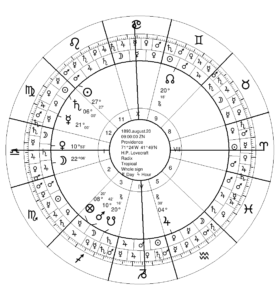the 200 Charts project
Introducing The 200 Charts Project: my mission to study and analyze 200 charts as one part of my astrological apprenticeship! And as a way to get past my chart-block, and get more confident in my astrology.
contents
- Introduction
- Background and Ideation
- How to Take Part:
- Choose Your Charts!
- Craft Your Rubric!
- Practice, Practice, Practice!
- Share Your Findings!
- Conclusion
introduction
Sometimes, when I’m reading or listening along, some seemingly offhand remark stops me in my tracks. I pause the podcast, or pull away from the book, think obsessively, and make several detailed notes. (Mercury in Scorpio!) Perhaps this is just a quirk, maybe it’s my personal daimon drawing my attention to something important.
In this case, I stumbled upon a comment by the late great Robert Zoller, mentioning the importance of rigorous practice for getting good at reading charts. He semi-arbitrarily chose the number 200 as a decent goal number of charts to fully delineate for practicing students. That number called to me in a strange way: 200 charts…
And that was it. I needed to do this. Delineate 200 unique charts as an astrology student’s rite of passage. Of course, I’ll still need to do live chart readings, read more texts, etc, however reading 200 charts is something that will undoubtedly improve my astrology.
background and ideation
Practice makes perfect, right? How then should we as student astrologers practice? For me, studying independently for the most part, I’ve had to arrive at my own conclusions, with the help of some amazing books and podcasts for sure!
See, here’s my experience: I listened to hundreds of hours of podcasts and YouTube videos, and read dozens of books on astrology, all the while looking at charts and trying out new shiny (or old and hoary) techniques. Then I moved on to the next book, next technique, next podcast. Never feeling super confident about my astrology, though I learned a TON.

All along, I knew what I needed (in fact, my Capricorn placements were screaming at me): solid, consistent, regular PRACTICE. This theme will come up several times in my writing, as it’s something I struggle with. This post is focusing on an element of practice that is crucial for astro students that already know the basics (planets, signs, houses, and aspects, as well as some planetary condition): reading and analyzing charts.
(NOTE: If you’re more of a beginner, scroll down to the Conclusion section, where I share a few resources to get you up to speed.)
And for some reason, this was tricky for me. I tended to get lost, confused, and frustrated looking at a chart. I would bounce around, maybe gleaning a few insights or noticing a particularly strong or debilitated planet, but then get distracted, or overly worried about whether a technical detail would override what I’m interpreting. Let’s just call this chart-block.
After learning of R. Zoller’s idea of 200 charts, I then heard Mychal A. Bryan on the Oraculos Podcast discuss the importance of following step-by-step rubrics when reading a chart.
And then it clicked for me: I can create my own rubrics based on the types of astrology I’m studying, and then plug and chug.
That’s when the 200 Charts Project was born. As one aspect of my Patreon, my blog, and on social media, I’ll be sharing the highlights of my journey, however long it takes. And I might even try some video chart walkthroughs if there’s interest!
I invite you to join me, in whatever way works best for you! Maybe you’re more loosy-goosy, and would like to simply pledge to look at more charts. Or maybe you’re more like me, and would like to catalogue your study of at least exactly 200 charts. Either way, jump in, the water’s great!
how to take part
- Choose Your Charts!
- Craft Your Rubric!
- Practice, Practice, Practice!
- Share Your Findings!
choose your charts!

Which charts should we use? Well, what sort of chart to use for astrological study and research is a perennial debate (we have a lot of those in our community, don’t we?). Ideally, you could research intensely the timed charts of family, friends, and other people you know closely, with whom you can review their own experiences on an ongoing basis. This is a huge benefit of being a consulting astrologer, since you get to explore the charts directly with the person. However, as a student of astrology, you might not be ready for regular readings, and could benefit from practice outside of the context of meeting directly with people.
I personally don’t have 200 friends and family charts, not even close, so the rest I filled out with celebrity and historical figure charts. I used Astro Databank and astro-seek.com to find timed charts of all sorts of people. I’d recommend sticking with charts that have a Rodden Rating of AA, A, or perhaps B, since they are more likely to have an accurate time. Something else to consider is how much information you have about this person’s life. At the very least, a short biography with significant personal details is preferred. This will help to verify or corroborate at least some of your interpretations.
I’m focusing on AA-rated charts, however I expanded a bit here or there to included a few charts I really wanted to look at. I used the narrowing down features to include some types of people, like religious figures, heads of state, actors, gay and lesbian individuals, philosophers, etc. I tried to include a wide range of professions and reasons for being famous. Of course, the list is tilted towards eminient indivuals, however this is the price we pay for the many many charts available for study. Personally, I plan on balancing this with private client chart study, once I open by books. I started with celebrities I liked or found interesting, then moved backwards in time
To organize this list, I created a spreadsheet. Here’s a link to a template of the spreadsheet I’m using. Just click File > Save a Copy and start using it! I included as much information here as seemed useful.
At a minimum, I include the name, birth data, Rodden Rating if available, and a few chart placements such as Ascendant, Sun sign, and Moon sign. If you’re using paid software such as Solarfire, or you’re using astro.com or astro-seek.com exclusively, you may prefer to organize yourself with these programs’ internal feature. But, I like a spreadsheet!
I also created Google Drive folders for each of the 200 charts (one at a time, though you could do it all at once, I suppose), since for each person I generate several charts and diagrams.
craft your rubric!
I explore the concept of rubrics in other posts, however the gist is, create a step-by-step exploration of a chart, and turn that into a checklist. This can be more or less flexible, and is highly dependent on your variety of astrology and your particular interests. If you’re newer, I’d recommend starting with a simpler rubric, centering around analyzing the ascendant and its ruler. As you gain confidence, I would then add on analyzing the condition of the 7 traditional planets (Saturn, Jupiter, Mars, Sun, Venus, Mercury, and Moon), and each of the 12 houses.
One way you can save your rubric is as a document with several questions that you answer and explore for each of your charts. Here’s a brief example of a questionnaire-style list for interpreting the Ascendant:
- What is the rising sign? What is the mode and element of this sign?
- What is the ruling planet of the ascendant and what sign and house it in?
- Are there any planets in the first house? What houses do they rule?
- What other house does the ruler of the ascendant rule, if any?
- What are the 2 or 3 closest aspects to the ascendant degree?
- What are the 2 or 3 closest aspects to the ruler of the ascendant?
- What is the essential dignity and debility of the ruler of the ascendant? Are there conjunctions, squares, and oppositions from the malefics OR trines and sextiles from benefics?
…and so on.
Once you get some practice with one rubric, you can expand on it, simplify areas that you find that you have found you have internalized, and create new rubrics that explore deeply certain topics, like career and vocation, or relationships.
practice, practice, practice!
- Make this a daily habit. I’m not quite to this point yet, however if you’re like me, you love astrology, so remember and feel that love; tap into that motivation if this practice ever begins to feel like a chore.
- Approach this practice as a sacred devotion. I believe that for all of the beautiful, intricate techniques that we have available and are creating, preserving, and rediscovering, astrology is at its core a sacred oracular practice. However this works for you, I’d suggest before every chart reading practice session, light incense or a candle, and meditate and/or pray. And cultivate gratitude for the planets, ancestors, and elders of astrological practice.

- Stay on track. Follow your rubric, and avoid distraction. If something in the chart calls to you but isn’t a part of your rubric, perhaps make a note of it, but set it aside for the moment. This helps develop focus and consistency. Now, if you’re prepping for or in a reading and something calls to you, that’s probably significant, however that’s a completely different context from practice chart reading
- Include interpertation as you go. When working through a chart, I can get stuck in the literal, analyzation mode: ASC is Libra, Venus is in Gemini in the 9th house, ruled by Mercury, Venus is combust the Sun, etc etc. And by the end of this, I am a bit drained and haven’t even gotten into interpretation mode, which is a core reason for practicing! What helps me is to interpret at each step. So I’ll note a Libra ASC, then reflect on some Libra keywords and anything I know about Libra Risings: tend to be attractive in a refined way, socialite, aesthetic, harmonious, charming, etc. Then you move to the next step in your rubric, analyzing the literal details of planet, placement, and condition, then adding some juicy interpretive notes. You might then start to see some repeating features and patterns, interpretive connections. Each individual chart feature then starts to contribute to a larger interpretive whole.
- Set aside the books and web. I know I’ve been there, I see a particular feature or configuration, and I want to flip open a book, or go a quick web search for more details. Don’t do it! At least not during your chart reading practice. You can always make time for some chart-specific research, but when you go to practice chart reading, practice chart reading! This has helped me quite a bit, and shown me that I know much more than I previously thought when I made myself dependent on outside sources. Then, once you’re done, yes, (for example) research about Caput Algol on the ASC degree, and the myths of Medusa, and feminist critiques and reinterpretations of the Medusa mythology. Just not during or instead of chart practice.
share your findings!
I’m making my 200 Chart Project semi-public, and I invite you to do so too! This motivates me to keep going, and to get comfortable sharing my messy, imperfect, in-progess self with the world. Which I hope will help others to get more comfortable being astrologers-in-training as well.
I’ll be doing ongoing posts sharing tidbits from some of my celebrity and historical figure charts, and my analyses of them. And I invite critique and expansion on my practice work as well!
Hashtags seem a bit passe, but I don’t care! I’ll be using #200ChartsProject myself when I share on social.
conclusion
Once again, I invite you to join me! And if you’re a complete novice or don’t feel ready, brush up with the following:
Sadalsuud’s Guide to Reading Your Own Natal Chart (@sadalsvvd)
Claire Moon’s Astrology Cheat Sheet (@ClaireMoonAstro)
I’m looking forward to hearing feedback on the project, my chart analyses, and hopefully others that this idea helps out!
Yours amongst the trees and under the stars,
